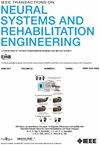理论驱动的脑电图指标,用于跟踪中风患者的运动恢复情况并预测 tDCS 与镜像疗法混合治疗的效果。
IF 5.2
2区 医学
Q2 ENGINEERING, BIOMEDICAL
IEEE Transactions on Neural Systems and Rehabilitation Engineering
Pub Date : 2024-11-08
DOI:10.1109/TNSRE.2024.3493926
引用次数: 0
摘要
脑卒中仍然是导致成人残疾的主要原因,这也说明了为什么研究工作会继续关注新的治疗方法和神经生理指标。虽然这些研究可能有效,但许多研究缺乏明确的理论框架。本研究首先确定了镜像疗法(MT)与经颅直流电刺激(tDCS)对运动前皮层或初级运动皮层的短期和持续临床疗效的最佳组合效果。然后,我们引入了由门控抑制模型衍生的脑电图(EEG)指标,以探索潜在的治疗机制。本研究中使用的脑电图指标侧重于运动产生的功能参与:颞叶区域(抑制非运动活动)和中央额叶区域(从抑制中释放运动区域)的α功率。结果显示,通过 Fugl-Meyer 评估(FMA)衡量的训练后益处在 3 种 tDCS 干预(运动前、初级运动、假)中相似。脑电图似乎对训练更敏感,前运动 tDCS 组的反应明显。训练三个月后,只有前运动 tDCS 组保持了 FMA 的进步,这些进步与脑电图指数相关。同样,这种模式也是前运动 tDCS 所特有的。由于抑制门控模型表明脑电图指数反映了个体的精神运动效率,因此我们还发现基线脑电图指数可以预测 FMA 的保持情况。我们的研究结果证明了前运动tDCS与MT联合治疗的优越性,并确定了颞叶和中央额叶区域的功能性振荡α波段活动可能是治疗机制的基础。个人的脑电图空间模式可有效预测上肢保持效果。本文章由计算机程序翻译,如有差异,请以英文原文为准。
Theory-Driven EEG Indexes for Tracking Motor Recovery and Predicting the Effects of Hybridizing tDCS With Mirror Therapy in Stroke Patients
Stroke remains a leading cause of adult disability, underscoring why research continues to focus on advancing new treatment methods and neurophysiological indexes. While these studies may be effective, many lack a clear theoretical framework. The current study first determined the optimal combination effects of mirror therapy (MT) with transcranial direct current stimulation (tDCS) on the premotor or primary motor cortex on its short-term and sustained clinical outcomes. We then introduced electroencephalogram (EEG) indexes derived from the gating-by-inhibition model to explore the underlying therapeutic mechanisms. The EEG indexes used in this study focused on the functional involvement for motor generation: alpha power at temporal regions (inhibiting non-motor activity) and central-frontal regions (releasing motor regions from inhibition). Results showed that post-training benefits, measured by Fugl-Meyer Assessment (FMA), were similar across 3 tDCS interventions (premotor, primary motor, sham). EEG seemed more sensitive to the training, with notable responses in the premotor tDCS group. Three months after training, only the premotor tDCS group maintained the gains in FMA, with these improvements correlated with the EEG indexes. Again, this pattern was specific to premotor tDCS. Since the gating-by-inhibition model suggests that EEG index reflects an individual’s psychomotor efficiency, we also found that the baseline EEG index could predict FMA retention. Our findings demonstrate the superiority of combined premotor tDCS with MT and identify functionally oscillatory alpha-band activity in the temporal and central-frontal regions as potentially underlying the therapeutic mechanism. An individual’s spatial pattern of EEG may be effective in predicting upper extremity retention effect.
求助全文
通过发布文献求助,成功后即可免费获取论文全文。
去求助
来源期刊
CiteScore
8.60
自引率
8.20%
发文量
479
审稿时长
6-12 weeks
期刊介绍:
Rehabilitative and neural aspects of biomedical engineering, including functional electrical stimulation, acoustic dynamics, human performance measurement and analysis, nerve stimulation, electromyography, motor control and stimulation; and hardware and software applications for rehabilitation engineering and assistive devices.

 求助内容:
求助内容: 应助结果提醒方式:
应助结果提醒方式:


